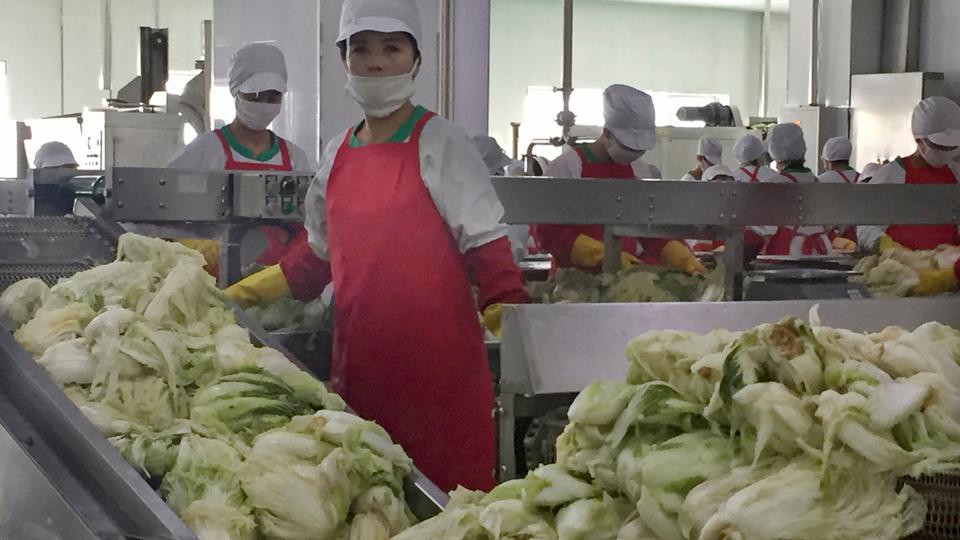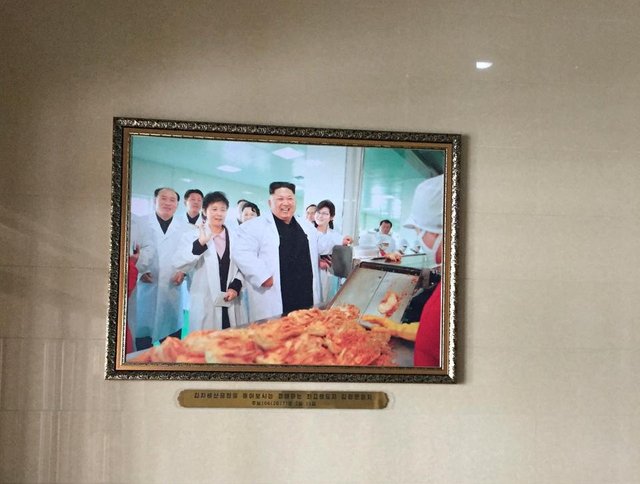Kim Jong-un's factory boasts of a one-of-a-kind "kimchi analyser" to maintain the proper levels of saltiness and lactic acid as part of his decision to turn the art of kimchi-making into a science.

Workers prepare kimchi on the production line at the Ryugyong Kimchi Factory on the outskirts of Pyongyang, North Korea. December 20, 2017.
North Korean leader Kim Jong-un wants to turn the art of kimchi-making into a science with his one of latest pet projects, the Ryugyong Kimchi Factory, which produces 4,200 tons of the iconic Korean pickled vegetable dish a year on the outskirts of Pyongyang.
The shiny new facility replaces an older factory and opened in June last year after getting Kim's final seal of approval, according to manager Paek Mi Hye.
Paek, who accompanied Kim on his "on-the-spot guidance" visits, said the factory has 150 workers but is for the most part automated.
She said the primary objective of the factory is to operate in a "scientific manner at every stage."
In kimchi-making, that means inspections all along the production line to ensure quality and hygiene. The factory boasts of a one-of-a-kind "kimchi analyser" to maintain the proper levels of saltiness and lactic acid — its signature ingredient.
The factory is intended to showcase Kim's efforts to boost North Korea's domestic economy and produce more, and better, consumer products.
His strategy, known as "byungjin," aims to simultaneously develop the national economy and North Korea's nuclear weapons programme.

Tradition of kimchi-making
Koreans – North and South – have been making kimchi for generations, often passing family recipes down from mother to daughter or mother-in-law to daughter-in-law.
Paek said some people might resist giving up the cherished tradition of communal kimchi-making. "But they also recognise the quality and reliability of our factory-made product," she said.
The factory produces eight kimchi products, from the very spicy staple "tong kimchi," which has a red tint and is made of whole cabbages, to a milder variety designed for children. Its kimchi products are distributed to restaurants and grocery stores around Pyongyang.
"This is the model," Paek said. "Other factories like ours are being planned in every province."
In 2015, UNESCO added kimchi to its "intangible cultural heritage of humanity" list, noting that the traditional sharing of know-how and materials to prepare large quantities of kimchi for the winter months "boosts cooperation among families, villages and communities, contributing to social cohesion."
Struggle over different areas
North Korea's repeated underground nuclear tests and launches of long-range missiles that could conceivably reach the US mainland have brought more sanctions down on the North than ever before.
But outside experts believe the country — while still struggling in many areas — is showing signs of modest economic growth and improved agricultural production.
It could be just a year or two away from having an operational, nuclear-tipped intercontinental ballistic missile.
Applied science, according to the North's policymakers, is absolutely essential on all fronts.
Hi! I am a robot. I just upvoted you! I found similar content that readers might be interested in:
http://nationalpost.com/pmn/news-pmn/secret-sauce-kim-jong-un-applies-science-to-kimchi-making
Downvoting a post can decrease pending rewards and make it less visible. Common reasons:
Submit